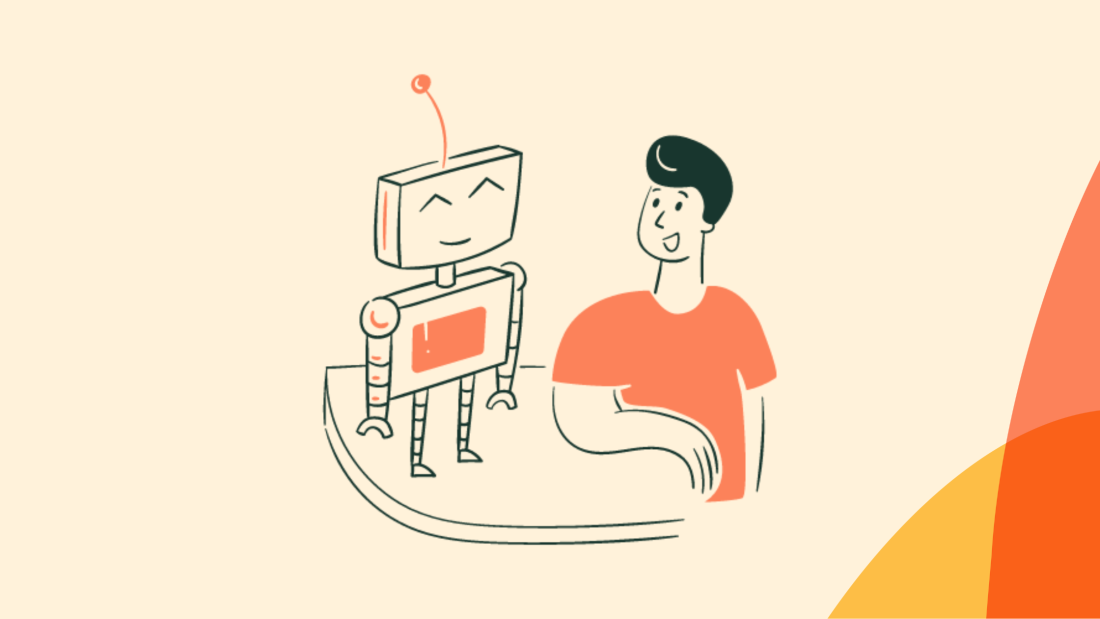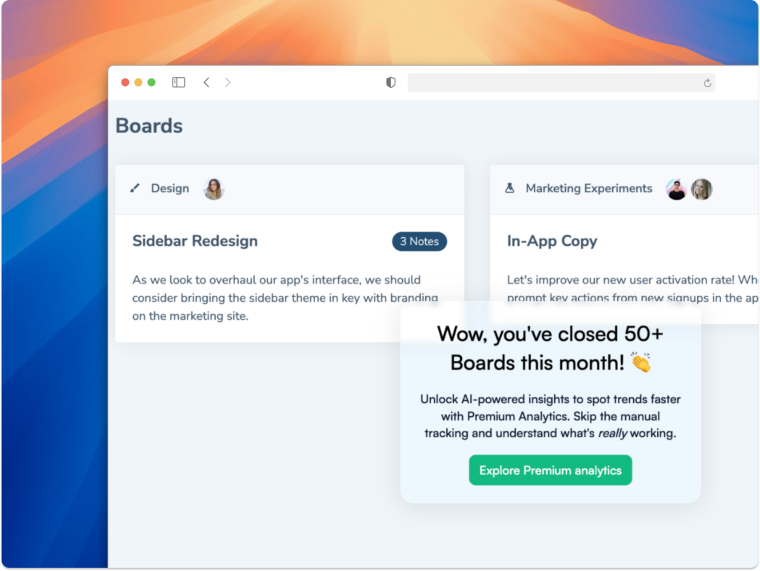How does AI impact UX design? This is the question that many UX and product teams are pondering as they welcome this new era of artificial intelligence tools. As AI becomes more prominent in product design, it is now more important than ever to maximize its advantages.
In this article, we'll take a close look at how AI influences and drives UX design—including the challenges to consider—as well as where it can be used in product design.
Artificial intelligence increases efficiency and productivity in product teams.
AI comes with challenges and considerations, such as privacy concerns, learned biases, and accuracy.
Many product development activities can be supported by AI tools, from UX writing to user research.
How does artificial intelligence impact UX design
Put simply, artificial intelligence opens doors when it comes to UX design.
It provides an innovative, exciting opportunity to create user experiences that are more personalized and effective than ever. It also makes life a lot easier for UX folk—whether that’s helping with interview question ideation or speeding up wireframe development.
AI in UX design impacts not only the final design but also the UX design process—as we’ll see throughout this article. However, it does pose some challenges that can’t be ignored—let’s take a look.
Challenges of using AI for product development
Just like any other emerging tech, artificial intelligence comes with some challenges to consider and hurdles to overcome.
Firstly, AI presents some key considerations when it comes to data privacy and security. In order to personalize experiences, AI must first process and understand vast amounts of customer and product usage data—including identity data, engagement data, behavioral data, and attitudinal data.
The challenge here is ensuring you collect and manage user data in a way that abides by data privacy laws—think GDPR, CCPA, and the like. Failing to do so could mean some pretty hefty fines, and also has huge implications for user trust and your brand.
Another key consideration is that AI can perpetuate and amplify pre-existing biases and prejudices in society. AI learns from the training data you feed it, so it’s your responsibility to take steps to mitigate potential biases—such as using diverse training sets and testing algorithms for biases. AI should help develop products and experiences that work for everyone—not just a select few.
You also want to keep in mind that AI is far from perfect—it’s up to you to write clear, precise prompts that enable the machine to generate what you’re looking for. AI for UX writing, for example, requires you to be exact in the details of what you're looking for. This includes expressing the tone, style, length, and focus of your desired text—and even then you still may need additional prompts to refine it.
Finally, a challenge often faced by product development teams looking to implement AI is that of stakeholder buy-in. Effectively communicating the value of AI, while still stressing its limitations, can be a difficult balance to strike. You want stakeholders to allocate budget for AI tools, but you also want to set realistic expectations about what it can do.
5 ways to use AI to improve the user experience
So, what can AI do to help you improve the user experience and support user success? Here’s how to use AI in UX design.
1. Create flow diagrams for user journeys
A key focus for UX designers when creating UX designs is to understand how users move through a product—what does their interaction and experience look like? User journey mapping is a crucial—and typically time-consuming—task for UX designers that involves researching users, analyzing vast amounts of data, and creating step-by-step flows.
It’s an important task that comes before any design ideation or generation—and it’s one that can be supported by AI.
AI can help in the user journey flow creation process in a number of ways:
Experiment with prompts for UX research to help you get more relevant feedback that uncovers user expectations, pain points, and more.
Generate flow diagrams in seconds to remove the manual work of developing your own. Plug in your data and watch as your flow chart is generated before your eyes.
Manage and evaluate user feedback to identify common problems and friction points for users. AI-powered NLP can read and understand the meaning of customer feedback to speed up the feedback analysis process.
AI can help speed up the customer journey flow mapping process substantially—freeing up your time to focus on other high-impact tasks that AI can’t handle.
2. Automate the UX design process
There are many ways that AI can automate the stages of the UX design process, from designing features, to prototype testing, to shipping new features. Automation is a huge time-saver in any process, and there’s plenty to automate when it comes to improving UX. Take a look:
Use AI to generate copy for UX designs in seconds, whether that’s in-app copy, help documents, or explainer emails.
Create visual elements for UX designs with AI-powered image generators.
Use Figma plugins to implement AI in your Figma designs—to generate wireframes or prototypes, for example.
Use AI to turn Figma designs into React code for speedier implementation and deployment.
Using AI during the UX design process makes everyone’s life easier—from the UX designers themselves to PMs to product engineers. Plus, there are plenty of AI options on offer—you can implement AI on a project-by-project basis.
3. Generate effective copy for in-product experiences
Let’s dig a little deeper into using AI to generate copy—specifically for in-app messages. Copy generation is an increasingly popular use case for AI, especially for SaaS companies and products.
AI copy generation tools are pre-trained natural language generation (NLG) models that use natural language processing (NLP) to understand prompts and generate relevant copy. Chatbots, voice assistants (like Siri or Alexa), machine translation tools, and more—including AI copy generators—use this technology to create copy.
When used in UX, we’re often looking at generating copy for in-app messages—launchers, tooltips, microsurveys, and the like. This is copy that users see within your product, helping guide them towards a desired action or unblock them when encountering unavoidable friction points.
That being said, the jury’s still out on whether AI-generated UX copy is as good as the real thing:
“It’s pretty generic unless you instruct it to inject some personality (e.g. “write this confirmation button in the style of William Gibson!”). I see more of an opportunity to help teams write product documentation, as writing in-product copy is more of an exercise in art and appealing to humanity. But I don’t doubt that it’ll get there.”
As we heard from Scott, the more developed and concise your prompt—the more accurate the generated copy. AI needs instruction, and it’s up to you to guide it in the right direction. Just like any other copy, you can A/B test generated copy to understand which performs best—something your AI model will learn from for future copy generation.
4. Use AI for product tours and walkthroughs
AI can also be hugely useful when creating personalized product tours and walkthroughs—like those that users encounter during user onboarding. Using AI throughout the tour creation process reduces the amount of manual work for the UX designer—and the greater product team—by automating key tasks. For example:
Generate AI visuals for product shots and videos from text prompts based on the look you’re going for to reduce the amount of time spent creating visuals for product tours.
Turn lengthy, in-depth documentation into shorter steps for product tours and walkthroughs with AI summarization.
Add an in-product AI chatbot to provide 24/7 personalized support to users. These chatbots are trained on your knowledge bases to enable users to spend less time looking for product support, and more time finding it.
Use AI in product analytics to get insights from large amounts of data, faster. AI can extract key insights from your product data to help you make more informed decisions.
Analyze customer feedback with AI-powered sentiment analysis to quickly uncover key insights in hundreds—maybe thousands—of replies.
AI isn’t doing anything new—it’s doing what you’ve always done, just quicker. Product teams have been writing help docs, creating tour visuals, and reviewing customer feedback since the dawn of product development—but it’s now possible to do it in seconds instead of hours.
5. Analyze large volumes of data more efficiently
Data analysis that typically takes humans hours of manual work can now be performed by AI models in seconds. AI can analyze both quantitative and qualitative data, and can uncover insights faster to enable your team to focus on tasks that can’t be performed by AI.
For example, we spoke to Scott about how—and why—the team at Churnkey has implemented AI data analysis on both qualitative and quantitative feedback:
“We analyze open-ended feedback at scale for user sentiment and categorization into specific response types. This is used by product, marketing, and customer-facing teams to make more informed decisions. We also extract key value metrics from the intersection of billing, invoicing, and customer activities to understand the traits of high-value customers. This is incredibly important for our customers with massive scale who need to re-evaluate their assumptions constantly over time.”
The benefits of implementing AI for data analysis are clear: improved efficiency when it comes to collecting key insights. It’s a quicker way to get the information you need to make well-informed decisions.
4 AI tools for SaaS you can use for product design
So, now you know you can use AI in product development, we expect your next question is how. These tools are the answer to your question—they’re AI-powered solutions helping UX designers—and plenty of other people—work more efficiently.
Let’s start with one you’ve definitely heard of—ChatGPT,
1. ChatGPT
ChatGPT is hands down one of the hottest AI tools currently in the market. To demonstrate its capabilities and to recap what ChatGPT is, we asked for a succinct answer to ‘what is ChatGPT?’:
“ChatGPT is an AI language model developed by OpenAI that can understand and generate human-like text responses for various tasks, aiming to simulate natural conversations and provide helpful interactions.”
Pretty cool, huh? One thing to keep in mind is the disclaimer included just below the search bar:
“ChatGPT may produce inaccurate information about people, places, or facts.”
Like any language model, ChatGPT generates responses based on patterns and training data. Training data can often include incorrect information—but ChatGPT isn’t able to recognize this, so double-check its answers.
When it comes to product design, ChatGPT can assist in design ideation, documentation creation, and can even simulate conversations with potential users.
2. Fin by Intercom

Fin is a customer support bot launched by Intercom using the same AI tech that powers ChatGPT: GPT-4. Fin is trained using your support and knowledge documentation, which you can upload for a demo on their site.
Fin helps you improve the customer experience by providing relevant, accurate support to your customers on a wide variety of topics. Fin helps your customer get answers, fast.
For example, Fin could be placed within your product to help unblock user-facing in-product issues. Instead of contacting customer support or diving into your knowledge docs, customers could simply ask their questions and receive the same answer they’d get from your team or docs—instantly.
3. AI plugins for Figma
Plugins are programs or applications created by the community—not Figma directly—that extend the functionality of Figma. AI plugins bring additional AI capabilities to Figma, such as copy generation, image generation, aesthetic optimization, and more.
Here are some popular Figma AI plugins to consider:
Automator: automate repetitive tasks with machine learning, such as icon creation and sizing, pattern creation, logo placement, and more.
MagiCopy: generate copy for your UX designs with simple prompts. You can even establish predefined rules to guide copy generation.
Builder.io: generate designs with AI and export them to responsive code. You’ll likely need to improve on the design and code, but it reduces manual work dramatically.
Attention insight: AI that predicts where users will look when viewing your design from preliminary heatmaps based on predictive eye-tracking technology.
There are plenty more where that came from—check out the full list of plugins tagged #AI on Figma. These plugins help improve efficiency in UX design and can help unblock designers facing inspiration-based blockers.
4. Chameleon

At Chameleon, we’ve added AI-backed features to our platform that enable you to generate in-app copy quickly and effectively. You can customize the format and tone of the generated copy, as well as optimize existing copy. The AI feature can be used to help you write better copy on body and title components, item descriptions, and launcher titles—for now, 😉.
It speeds up the design process by improving the copy creation and optimization process to help you deploy solutions that improve the user experience for your customers.
👉 You'll find AI in other features in Chameleon, such as A/B Testing. Check out this interactive demo to get a preview.
Using AI in your product development process
You know what they say: there’s no time like the present. That rings especially true when it comes to embracing the future.
AI is nothing new, but its accessibility is. The latest tools and solutions have taken artificial intelligence mainstream for businesses like yours to implement across business operations.
Product development and user-centric design are, and should always be, human-focused and driven by core UX principles. AI isn’t here to replace you, it’s here to support you.
So, let it.
If you want to start leveraging AI to create more effective user experiences, try Chameleon and its

Create effective UX with Chameleon's AI feature
Harness the power of AI with Chameleon and generate copy that drives engagement.







